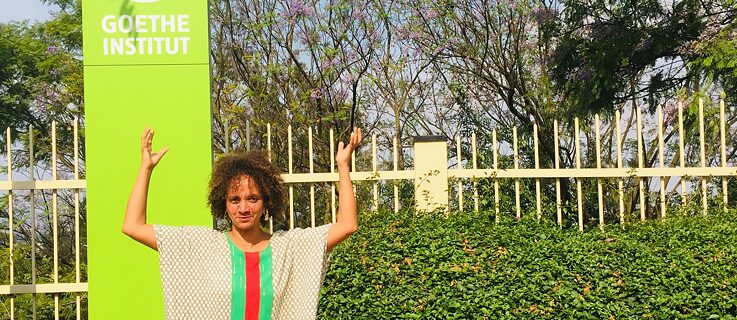The artwork of the multimedia artists Syowia Kyambi with Kenyan-German roots is part of the exhibition #FAVT: Future Africa Vision in Time. The exhibition is having its last stop in Kigali from November to December 2019.
#FAVT is opening on November, 15th 2019 here in Kigali. In this exhibition we will experience your work “My mother’s mother”. With this sound-installation you are again addressing the topics “womanhood/motherhood”, “remembering”, “identity”... What may we expect?
The work „My mother’s mother” was really inspired by the curiosity on hearing women’s voices about how they navigate their personal lives, their career lives, their lives as mothers, as wives, as women, as lovers and what they think. Because often they are navigating also the spaces or ideas that they are not allowed to be in a certain way or they cannot balance their life-work-career. It is just hearing from them how they navigate and what they think.
It is really an installation with teacups and sound. When you enter the space you hear a kind of a rumbling and many voices talking at once. It is kind of the way like you would enter to a coffee house or a shop or entering the living room people having dinner. When you put the cup to your ear you hear a single voice, a single story. These voices are from Kenya/Nairobi, Germany/Bayreuth and Frankfurt and also Kigali.
How is your work embedded in the bigger frame FAVT is giving? What does the subtitle “Eine Ausstellung als Entwicklung“ mean to you?
FAVT is designed as an ongoing process. It was created in a way for curatorial students to practice the reality of curating not only the theory or the thinking. It is about building an exhibition, the chances and adapts to the space. I think what happened to “My mother’s mother” in Kigali is an interesting example. The curator Gloria Igabe approached me and was kind of keen to have Kigali´s women’s voices. The work was flexible to shift, to accommodate that idea. This is a good example for an exhibition as process or progress. That it is not static but fluid.
- You are an artists, who is working with different media, but also with her own body and performatively. What role is performance and therefor also the element of surprise respectively spontaneity for your art?
My practice is held by two or more arms in a sense: There is always a research component and a kind of reflective reading, thinking and a talking process in the progression in my practice and the process of making work. And there is always the instinctual kind of guide within my process, where I am looking to listen to the body and to my instinct. Sometimes I use materials or create approaches where I don’t really know what the outcome is. I know it is important but I don’t know the meanings behind it. Sometimes those come after. The same happens for me when I am working performatively. My performances are pre-planned and organized in terms of moments and maybe sometimes in terms of order but the intuition also plays a strong role there. It is not like a script of a theatre play. It is influenced by audience reactions and also by my own process as I am doing the work live: Things shifting and fluidities are really important.
How are you experiencing the „art scene“ in East Africa? Maybe also in comparison to Europe?
Working in different spaces and places – most in Nairobi for me and more recently in Tanzania – I think there is a freedom of materiality and freedom to try different things out in East Africa. It is not that formalized like in the Western World. So formal, that you cannot explore with the people anymore in a really free way. Example: If I go to a hardware shop somewhere in Nairobi and I want to try something out, people are pretty willing and like “Yeah, let’s do this”. Whereas if I go in one in Europe it is more like: “This is the standard. This is what we do and now you choose.” It is not like “Let’s try this out and let’s try that out.” This is really in spaces where one buys materials: hardware stores, wood shops…
Collaborative work is very fluid in both spaces. There are always groups of people I find who are really interested and open and willing to find out more about what I am thinking and doing and want to explore with me what they are thinking and doing. There is a kind of mutual exchange that is taking place.
The biggest challenge I find myself in East Africa is that the art scene is kind of consuming work. It is commercial work. So it needs to be formatted in a very commercial way for a living room environment and not for creating or generating difficult dialogs. The selling is in the forefront which is not the core of what art is about. That is making work that is asking people to think and to reflect and making dialog around difficult issues. That is a platform that is not offered very often. Or if it exists it needs to be built from the scratch and that is quite difficult. Whereas in Europe you have quite a lot of spaces that are funded to facilitate those kinds of artworks and engagements.
